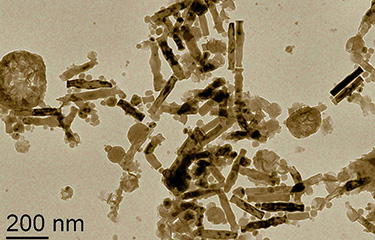Scientists at the International Iberian Nanotechnology Laboratory (INL) in Portugal have been undertaking research into the health risks associated with human ingestion of nanoparticles found in aquaculture products.
The lab’s Nanoculture Project is investigating the presence and effects of the most-used nanoparticles, titanium dioxide and silver, in turbot, mussels, and the seaweeds dulse and sea lettuce, all of which are farmed in the Atlantic Ocean.
Nanoparticles are a new family of materials, measuring under 100 manometers (to provide context, a sheet of paper is around 100,000 nm thick), with a variety of industrial uses. Their potential impact on human health and the environment is currently under-researched and remains unclear, according to INL Water Quality Research Group Head and Nanoculture Project Administrator Begoña Espiña.
Titanium dioxide and silver nanoparticles are found in numerous consumer goods. Their popularity arises from unique optical, catalytic, and antimicrobial properties, making them invaluable for use in water filters, paints, cosmetics, sunscreen, detergents, clothing and other textiles, food packaging, medical devices, and electrical appliances, among other uses. They also have applications in industrial aquaculture, where they are used to improve the quality of aquafeed, water, and effluent, and also for controlling infectious diseases. With aquaculture becoming a more important source of high-quality protein and a vital contributor to future food security in Europe and beyond, the work of the INL scientists is timely, Espiña said.
“The number of applications to use these two nanoparticles is increasing, leading to disquiet about their potential input into aquatic ecosystems, harm to the environment, the toxicity of nanoparticles in aquaculture products, and the potential risk to humans of consuming them,” Espiña told SeafoodSource.
The Nanoculture Project, which includes partners in France, Ireland, Portugal, the U.K., and Spain, aims to investigate the impact on human health of ingesting these nanoparticles and methods to ways to mitigate their effects, in order to safeguard future sustainable development of the aquaculture sector.
Espiña explained that a lack of joined-up information about the effects of the nanoparticles in water, organisms and humans, is in part a consequence of the limited number of robust analytical methods available for detection.
The scientists are working to improve this situation and will reveal new analytical methods to facilitate detection, characterization, and quantification of nanoparticles in the environment and seafood, and Espiña said she expects the lab to release the findings of their research at the end of October – along with recommendations for procedures to help food manufacturers mitigate risk in product development.
“Unlike previous studies, we have undertaken our research using samples destined for human consumption both in their growing environment and in the laboratory, and analyzed the effects of exposure to nanoparticles in terms of water-filtration capabilities, physiological effects, and uptake and elimination profiles. The nanoparticle sensors we have developed will enable aquaculture companies to carry out real-time on-site monitoring,” she said.
The laboratory experiments used commercial grade nanoparticles of 30 to 40 nm in length, and smaller, 5-nm titanium dioxide nanoparticles and 15-nm silver particles to assess the likelihood of accumulation in marine food exposed to low concentrations likely to be present to be in the marine environment.
“We found that accumulation rates and molecular effects differed between the species. Accumulation in the flesh of turbot was low, but higher in organs such as the liver and kidneys, which tend not to be eaten,” Espiña said. “Mussels had higher levels of accumulation, and this may need to be taken into account when looking at the environment in which they are farmed.”
The two seaweed species that were studied, dulse and sea lettuce, also had nanoparticals present.
"Nanoparticles were also found in the seaweed species, but at different concentrations and although seaweed is not widely eaten in Europe, there is growing interest in its use as a food," Espiña said. "It is possible that precautions may need to be taken with particular species, related to where it is cultured in future."
Samples tested directly from aquaculture farms found no significant concentration in any of the species, although titanium dioxide nanoparticles were identified.
“Our research has thrown up much to analyze. We are currently compiling our recommendations, writing the final project report and preparing a white paper, and expect to continue with these important studies,” Espiña said.
Espiña said the most-recent reports on predicted concentrations of both types of nanoparticles, which found that silver nanoparticles tend to present in surface waters, while titanium dioxide is found in seabed sediment, from where it can be resuspended. Concentrations of titanium dioxide are particularly linked to bathing waters, due to its use in sunscreen.
There are differences of opinion about the toxic effects of these nanoparticles, but titanium dioxide in particular has been classified as a carcinogen if inhaled.
In May 2021, the European Food Safety Authority (EFSA) published an opinion stating that titanium dioxide could no longer be considered safe when used as a food additive. Previously, it had been popular for use as a whitening agent. As a result, the European Commission and Member-States agreed to stop its use for this purpose and a regulation was drawn up withdrawing authorization for its use. A six-month transitional period was included to allow food businesses time to reformulate their products using suitable alternatives, and its use in food became illegal on 7 August, 2022.
Photo courtesy of Georgy Shafeev/Shutterstock







